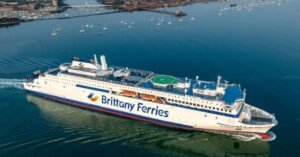The largest hybrid ship in the world is Saint-Malo, the flagship of Brittany Ferries.
This hybrid RoPax vessel is owned by Stena AB. It was built in 2024 by AVIC CMI Jinling Weihai Shipyard, China.

This ship is representative of a major leap in sustainable maritime technologies. It combines advanced battery systems, LNG propulsion and great amenities for passengers.
The 195 m long and 28 m wide hybrid ship operates on the route between Portsmouth, U.K and Saint-Malo, France.
From February 2025, it replaced another ship which sailed on this route, and it now offers regular overnight sailings for vehicles and passengers.
The largest hybrid ship has a gross tonnage of 30,000 tonnes and a cruising speed of up to 23 knots and 17.5 knots on battery power alone.
It has 10 decks, can accommodate 1310 people and has 386 cabins. The vehicle capacity is 470 cars and 63 freight vehicles.
Saint-Malo boasts the largest marine battery system ever installed on a ship.
Its battery system has a capacity of 11.2 to 12 MWh, and the batteries can be charged using shore power.
The system also includes advanced technology from Leclanche, especially the Navius MRS-3 Marine Rack System.
There are 4 battery compartments onboard, and the lithium-ion cells provide high-energy density and a long cycle life, up to 7000 cycles at 80% depth of discharge.
The largest hybrid ship also utilises liquid cooling for efficient thermal management and extended system life.
It has two Wärtsilä 12V46DF dual-fuel engines, producing a total of 27,480 kW (approximately 36,840 horsepower). They can run on LNG, marine diesel oil and can be upgraded in future to operate on alternative fuels or larger batteries.
The engines work along with the battery system, hence the ship can operate in full-electric mode during port manoeuvres and while docked, with zero emissions.
Wartsila’s LNGPac system allows for safe and efficient LNG delivery to the engines, and the intelligent energy management system optimises the use of engines and batteries for maximum efficiency and minimal emissions.
It features spacious interiors designed by Figura Arkitekter AB with influences from the region of Brittany. Comfort is the priority, and there are onboard dining options, lounges and many family-friendly facilities.
Systems like selective catalytic reduction (SCR) reduce nitrogen oxide emissions. The hybrid system decreases fuel consumption by 9% and greenhouse gas emissions by up to 15% compared to diesel propulsion.
Before the Saint-Malo, the MS Color Hybrid held the title of the largest plug-in hybrid ship in the world.
It entered service in 2019 and is operated by the Color Line on the Sandefjord, Norway to Strömstad, Sweden route.
It is 160 m long and can carry 2000 people and up to 500 cars.
The battery System consists of a Siemens 5 MWh battery pack, weighing 65 tonnes.
The battery-only operation mode provides an hour of sailing at speeds of up to 12 knots, used for emission-free operations in and out of ports and coastal areas.
Batteries can be charged using shore power at Sandefjord or by the ship’s diesel generators.
The ship also has a 5 MWh heat reservoir, which recovers waste heat from engine cooling and exhaust for onboard heating, improving energy efficiency.
MS Color Hybrid was developed by Fosen Yard and awarded the Next Generation Ship Award at Nor-Shipping 2017.
Ships like the Saint Malo and MS Color Hybrid are setting new standards for hybrid maritime vessels. They are helping decarbonise the maritime industry, which is the need of the hour.
You might also like to read-
- The World’s Biggest & Most Advanced Cable Laying Vessel
- What Are Exploration Vessels?
- What Are Nuclear Vessels?

